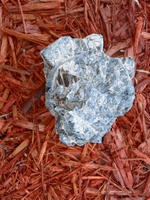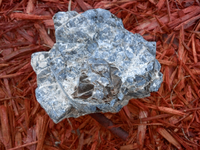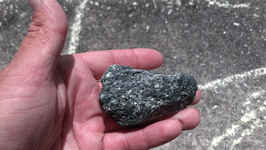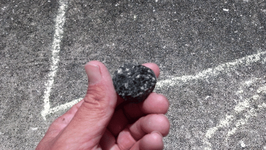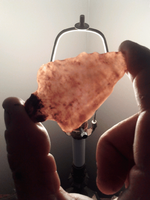Navigation
Install the app
How to install the app on iOS
Follow along with the video below to see how to install our site as a web app on your home screen.
Note: This feature may not be available in some browsers.
More options
You are using an out of date browser. It may not display this or other websites correctly.
You should upgrade or use an alternative browser.
You should upgrade or use an alternative browser.
any ideas im thinking maybe flint
- Thread starter mike a
- Start date
Eu_citzen
Gold Member
- Sep 19, 2006
- 6,484
- 2,111
- Detector(s) used
- White's V3, Minelab Explorer II & XP Deus.
- Primary Interest:
- Prospecting
I think you might be looking at a chert. It does at least look like some kind of chalcedony.
Flint is formed in sedimentary rocks, often found on beaches.
Chert is about the same thing, just not found in sedimentary rocks. Well, that is if my memory serves correctly.
Flint is formed in sedimentary rocks, often found on beaches.
Chert is about the same thing, just not found in sedimentary rocks. Well, that is if my memory serves correctly.
Upvote
0
Bajahunter
Sr. Member
- Mar 26, 2011
- 265
- 107
Mike A
Your rock is either flint or chert. There is a distinction between the two, but depending on which web site, book, or geologist you are seeking info from, the names become almost interchangeable. What people in some regions call flint other regions might call chert. Some people make the distinction based on color, with flint being darker.
My books say chert is the one affiliated with sedimentary rocks but flint can be found in chalk beds ( which is also a sedimentary rock).
There are many different names (regional and scientific) for all the different types of microcrystalline SiO2.
So don't get too hung up on a name. You have a piece of microcrystalline silicon dioxide that you can make arrowheads out of.
My name for what you have is chert.
"So both Eu and I think it is chert. We just disagree on what chert is." If I had a sarcasm font, the sentence in quotes would use it.
Rob
Your rock is either flint or chert. There is a distinction between the two, but depending on which web site, book, or geologist you are seeking info from, the names become almost interchangeable. What people in some regions call flint other regions might call chert. Some people make the distinction based on color, with flint being darker.
My books say chert is the one affiliated with sedimentary rocks but flint can be found in chalk beds ( which is also a sedimentary rock).
There are many different names (regional and scientific) for all the different types of microcrystalline SiO2.
So don't get too hung up on a name. You have a piece of microcrystalline silicon dioxide that you can make arrowheads out of.
My name for what you have is chert.
"So both Eu and I think it is chert. We just disagree on what chert is." If I had a sarcasm font, the sentence in quotes would use it.
Rob
Upvote
0
Eu_citzen
Gold Member
- Sep 19, 2006
- 6,484
- 2,111
- Detector(s) used
- White's V3, Minelab Explorer II & XP Deus.
- Primary Interest:
- Prospecting
Like I said, "If I remember correctly." I wrote that without consulting with my books.
Learnt something new today.
According to my books chert occurring as a concretion is called flint, usually found in chalk beds.
Learnt something new today.

According to my books chert occurring as a concretion is called flint, usually found in chalk beds.
Upvote
0
GatorBoy
Gold Member
- May 28, 2012
- 14,716
- 6,156
- Primary Interest:
- All Treasure Hunting
thought I might chime in.. since most of my expertise is in the native american culture of florida."chert" is silica replaced limestone. formed over ancient see beds. over thousands of years the silica exoskeletons of marine organisms gathered on the bottom of the ocean to form thick layers. when over naturally occurring limestone its filled in the spaces of the pouris limestone eventually replacing it. you end up with silicafied limestone or chert. which is a micro granular quartzsite. that was just off the top of my head forgive me if I had a mistake somewhere in there. but I think that does it.
Upvote
0
Bajahunter
Sr. Member
- Mar 26, 2011
- 265
- 107
Always
Thanks for your definition. That is as concise and well stated as anything I have seen written.
Now how do you differentiate flint?
I see flint listed as dark grey chalcedony, high quality chert (pure concretions of diatoms), and sometimes opal.
There is a big bed of diatomaceous earth about five miles from me. Part of a early Sea of Cortez that was lifted up.
Thanks for your definition. That is as concise and well stated as anything I have seen written.
Now how do you differentiate flint?
I see flint listed as dark grey chalcedony, high quality chert (pure concretions of diatoms), and sometimes opal.
There is a big bed of diatomaceous earth about five miles from me. Part of a early Sea of Cortez that was lifted up.
Upvote
0
GatorBoy
Gold Member
- May 28, 2012
- 14,716
- 6,156
- Primary Interest:
- All Treasure Hunting
yeah that 1 gets confused a lot. a lot of it had to do with where you came from. technically speaking.. chalcedony.. is a micro fiberous quartzsite.. whereas flint is nonfiberous. chert included. flint is formed in chalk while chert is not. they are both microcrystalyne quartzsite. people from england usually use the term flint because most of thier microcrystalline quartzsite is formed in chalk beds. but it normal conversation here in the united states especially between archaeologists chert is of lower quality larger grained and may include numerous fossil inclusions. while flint will be more solidified.
Upvote
0
GatorBoy
Gold Member
- May 28, 2012
- 14,716
- 6,156
- Primary Interest:
- All Treasure Hunting
www.mil.org/minerals/phototraprock
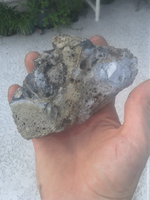
after the discussion about chert and flint I took another look at the photo. I believe the stone you have there is referred to as traprock. a form of basalt. it originates from magma. it often displays small air bubbles and sometimes it glasss like extrusions similar to obsidian. it is commonly used as railroad ballast. I gave you the link so you could see for yourself and make your own decision.. I could be wrong.

after the discussion about chert and flint I took another look at the photo. I believe the stone you have there is referred to as traprock. a form of basalt. it originates from magma. it often displays small air bubbles and sometimes it glasss like extrusions similar to obsidian. it is commonly used as railroad ballast. I gave you the link so you could see for yourself and make your own decision.. I could be wrong.
Last edited:
Upvote
0
centfladigger
Hero Member
since you found it on the tracks it could have come from the phosphate mines, I grew up finding sharks teeth on the railroad tracks, still do. They and rocks fall from the cars after they left the mines.
Upvote
0
centfladigger
Hero Member
let`s not forget my favorite rock found here and that is coral.
Agatized Fossil Coral… is scientifically identified as a "chalcedony pseudo-morph after coral." it is ancient coral that gradually turned into the gemstone agate.
7 on the Mohs scale















Agatized Fossil Coral… is scientifically identified as a "chalcedony pseudo-morph after coral." it is ancient coral that gradually turned into the gemstone agate.
7 on the Mohs scale















Upvote
0
centfladigger
Hero Member
ummm...where are you going with this guys post? oh well here is one I found
I went with another rock ID found in Fl. so when he comes back down he might have an idea of what to look for
Upvote
0
- Thread starter
- #15
Thanks everyone for the info. I do believe you are right about what i found always learning. I love the agatized coral pics also i will look for some one day. I am planning a move back to port st lucie fla i am origanally from there and want to go back just hard to talk wife into it lol. But i will have more time to look next time i am down there any ideas of where to look for some of the coral tips hints anything
Upvote
0
GatorBoy
Gold Member
- May 28, 2012
- 14,716
- 6,156
- Primary Interest:
- All Treasure Hunting
ha ha... we might have been neighbors. if you ever know you're getting down this way hop on here and let me know. maybe then we could talk. with all the internet searches I do.. including for things on this site I see these threads splattered all over the internet.
Upvote
0
Top Member Reactions
-
 3358
3358 -
 1983
1983 -
 1932
1932 -
 1165
1165 -
 1097
1097 -
 890
890 -
 807
807 -
 796
796 -
 796
796 -
 788
788 -
 756
756 -
 538
538 -
 486
486 -
 460
460 -
 444
444 -
 427
427 -
 422
422 -
 420
420 -
E
411
-
 383
383
Users who are viewing this thread
Total: 2 (members: 0, guests: 2)
